There are a lot of things to think about when picking a new pup for your family.
Among other things, you’ll want to consider your new dog’s size, temperament, energy level, and care requirements before making a decision. But it is also important to think about your local climate when selecting a new pet. This is especially important for those that live in areas with unusually high or low temperatures.
We’re going to focus on those in the latter category today, so kick back and bundle up while we talk about 10 canines who love cold climates.
The Ten Best Cold-Weather Dog Breeds
There are a number of breeds who are comfortable in relatively chilly weather, but the following 10 are among the best suited for sleet and snow.
1. Siberian Husky
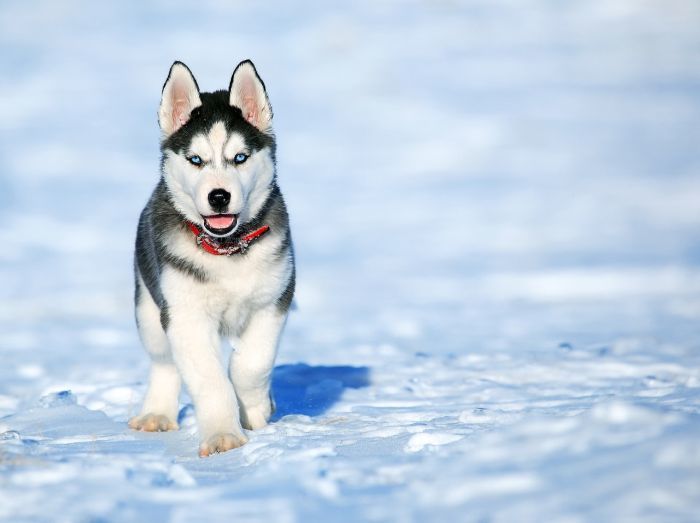
Given that they were developed in Siberia – a land synonymous with cold, bleak weather – huskies are quite at home in places where winter winds blow. In fact, they’re still used by some Iditarod teams, even though they aren’t as fast as some of their competitors (several of which also appear on this list).
Huskies are pretty popular among pet lovers too, and the reasons are pretty obvious: They have a beautiful, wolf-like look to them, they’re loving, intelligent, and they’re always up for a good time.
That said, they do have very high exercise requirements, and they can develop destructive tendencies if they aren’t allowed to burn off enough energy, so they aren’t a great choice for homebodies.
If you’re a husky fan, also consider checking out our list of husky mixed breeds – there are some pretty cool cross breeds in there!
2. Great Pyrenees
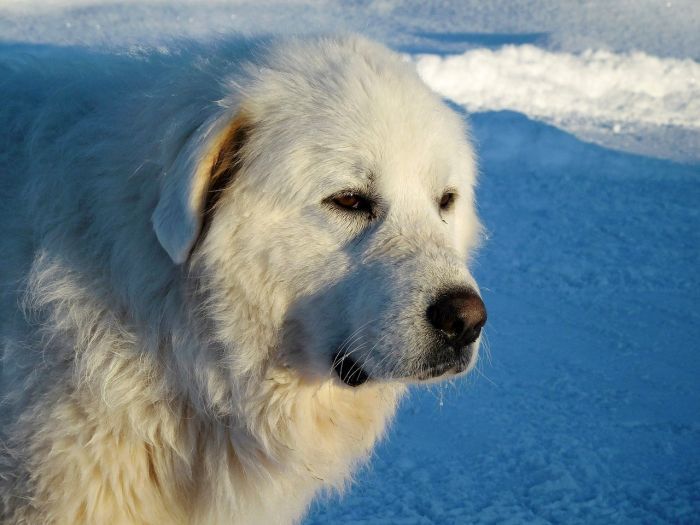
Great Pyrenees were originally developed to live with a flock of livestock and keep them safe from danger. Their long coats helped them do this by:
Providing protection from the wolves and other predators these pups may need to battle.
Helping the dogs look a little more sheep-like, which appears to make the sheep feel better.
Keeping the dogs warm while sleeping outdoors alongside the sheep.
Because they were bred to live away from their owners, Great Pyrenees are not quite as affectionate as some other breeds. They love their families, and they can make good pets in the right home, but they’ll never follow you around like a shadow.
But this can be a good thing for some families, as Great Pyrenees aren’t very prone to separation anxiety. They do, however, need a big yard to patrol, and they aren’t the easiest breed to train (they’re a bit stubborn). So be sure to meet a few Great Pyrenees before you add one to your home – especially if you are looking for a first dog.
3. Tibetan Mastiff
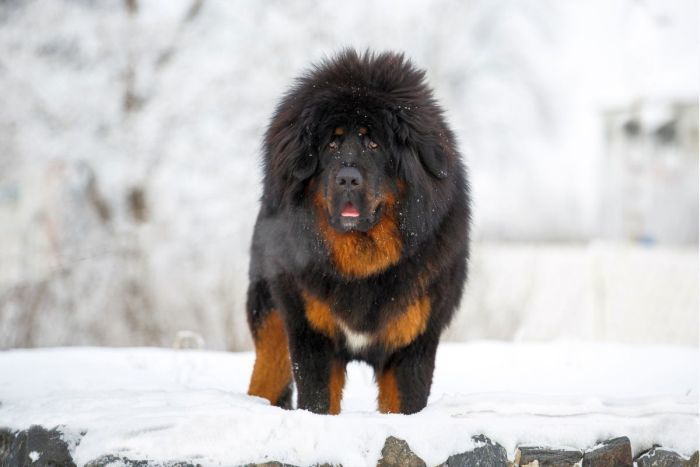
You better live in a pretty cool climate if you add a Tibetan mastiff to your family. They can handle cold temperatures just fine, but they can overheat very easily on hot summer days.
Tibetan mastiffs are covered in an unbelievably long and fluffy double coat, which helps keep them warm in even the coldest weather. Like Great Pyrenees, their long coats also help to accentuate their size and provide protection from the wolves and bears they’d be expected to fight off while guarding livestock and their owners.
Tibetan mastiffs are gigantic dogs, who occasionally reach 150 pounds or more in weight! This, combined with their headstrong nature, makes them challenging dogs to own.
For an experienced owner, one of these enormous pups may be a manageable option, but for the novice owner, it would be an inappropriate match.
4. Alaskan Malamute
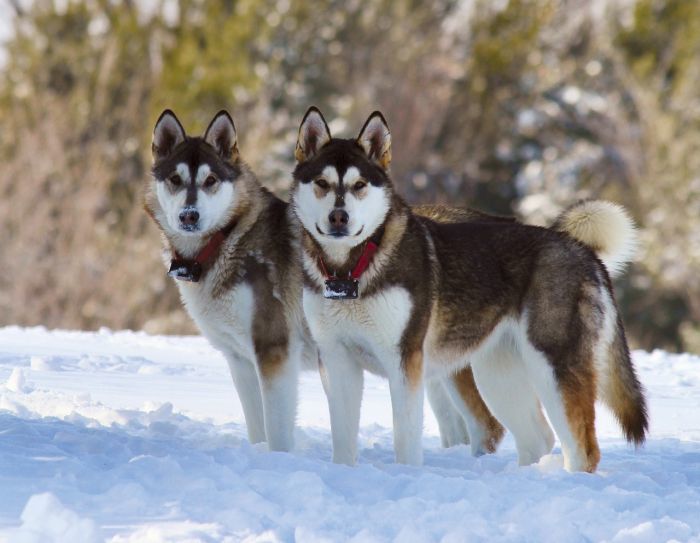
You’d probably expect any breed named after the 49th state to be well-suited for the cold, and in the case of the malamute, you’d be right.
Malamutes are burly sled dogs, built to drag heavy loads. Although they’re big (some flirt with the 100-pound mark), they look even bigger than they are, thanks to their luxurious coats.
Malamutes are really friendly dogs, who typically greet strangers with a wagging tail. But, they can be a bit antagonistic toward other dogs, and they’re often quite aggressive toward cats.
As with almost all other breeds, they’ll benefit strongly from early socialization and training.
5. Saint Bernard
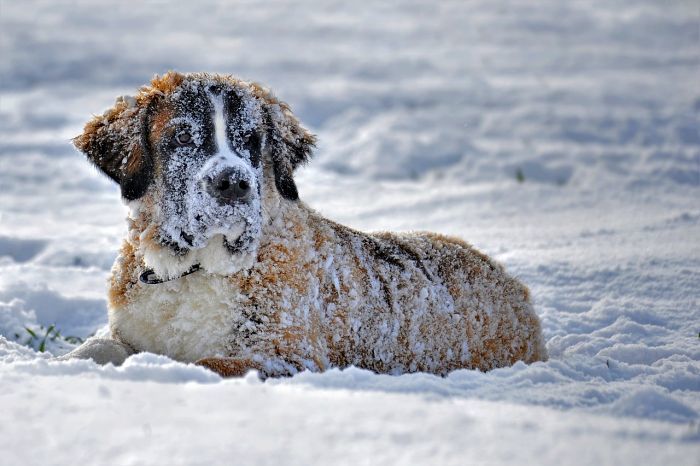
Saint Bernards have a history of working for long periods outdoors in bone-chilling temperatures. They were originally bred to perform a variety of tasks, but they’re most celebrated for helping to find and rescue injured or lost individuals visiting the Swiss Alps. The whole barrel-of-brandy-around-the-neck thing is probably just a myth, but I like to think it’s true.
Saint Bernards are gigantic dogs – big individuals approach 175 pounds and stand 30-inches-tall at the shoulder. Although these gentle giants are great with kids and make friends with ease, they are quite stubborn and often challenging to train. Accordingly, most first-time owners should look for another cold-weather breed.
6. Samoyed
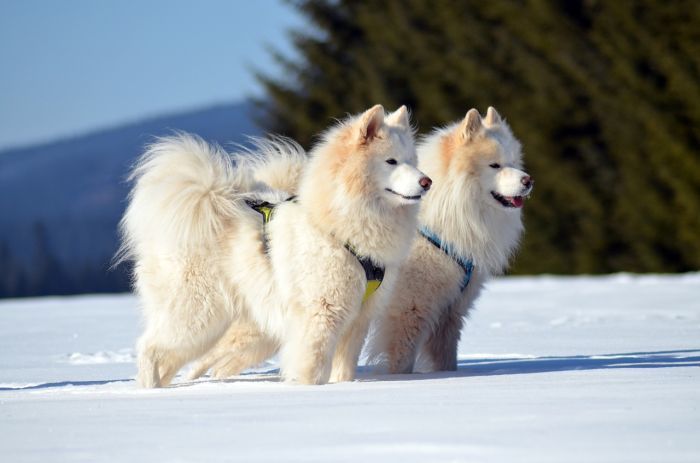
Originally developed to herd livestock and pull sleds across the frozen Siberian wilderness, Samoyeds were eventually tasked with performing an even more important task – keeping their owners warm during cold winter nights. This means that Samoyeds are not only spectacularly well-suited for cold weather, they also love snuggling with their people!
Samoyeds are pretty happy-go-lucky dogs who are always looking for an adventure. They’re extremely loving and affectionate with their families, but they aren’t especially brilliant, nor are they very interested in pleasing you by learning commands and tricks.
They also require quite a bit of regular grooming, so, while Sammies (as they’re often called) certainly have a lot going for them, they aren’t an ideal choice for those who are new to dogs and owners who don’t want to spend a decent chunk of change taking their pooch to the groomer each month.
7. Bernese Mountain Dog
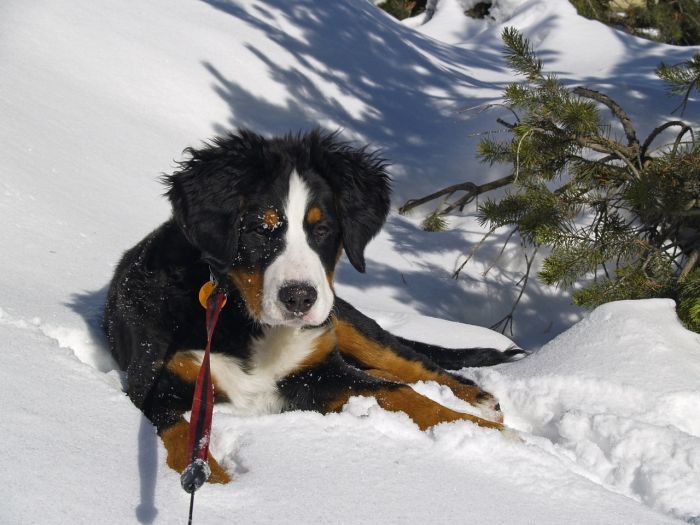
Were they not quite so big, Bernese Mountain dogs would probably be one of the best dogs for new owners in the world. But alas, these affectionate and loveable goofballs range from about 75 to 125 pounds, which is a bit big for dog-owning novices.
Nevertheless, Bernese Mountain dogs are remarkably likable dogs, and they are right at home in cold climates. Originally developed in Switzerland, these dogs were responsible for hauling heavy loads and guarding livestock. Bernese Mountain dogs have a very dense fur coat, which will keep them warm in all but the lowest temperatures.
These are very high-energy dogs, so it is important to provide them with a big yard and plenty of opportunities to exercise. Bernese Mountain dogs are quite smart, and most love pleasing their person, so they often excel at obedience trials.
8. Newfoundland
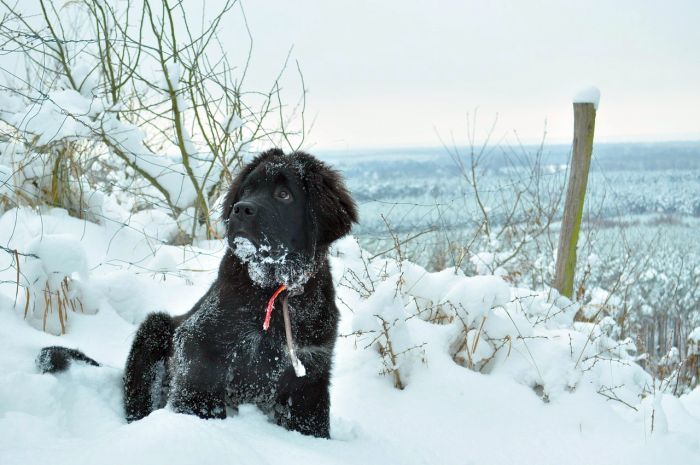
The very image of a working dog, the Newfoundland has performed a number of jobs throughout its history. However, they’re most noted for helping fishermen work the nets. To carry out this kind of work in the frigid waters of Newfoundland, they needed a dense, water-resistant, double-coat (not to mention a love of the water).
Newfoundlands are famous for their gentle demeanor and calm disposition. They aren’t as bubbly as some of their retrieving cousins, like Labrador retrievers, but they make friends easily enough. They are much stouter than your average retriever, and they exude power with every step.
Newfoundlands are smart, capable, and eager to please, and they can make pretty good pets for those with the space and time to dedicate to such a big and playful animal.
9. Akita
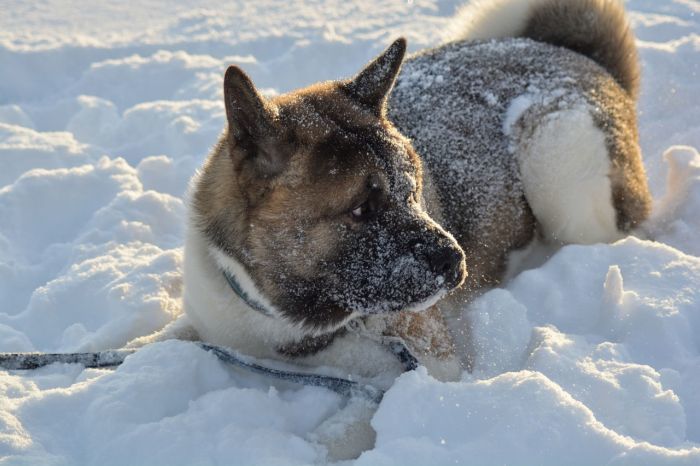
Akitas have one of the most luxurious coats you’ll ever feel, and it is just as effective against the cold as you’d think it is. Akitas are very well adapted to winter weather, and their robust bodies make their dense double-coats even more effective.
One of the bravest dogs ever bred, Akitas have been tasked with guarding royalty as well as hunting boar, bear, and other formidable prey. They love their family deeply and form very strong bonds with their owners, but some Akitas can be described as “prickly.” Most are suspicious of other people and often have trouble getting along with other dogs.
The combination of their large size (some individuals exceed 120 pounds), power, and protective nature makes them a poor breed choice for beginners. But experienced dog owners looking for a loyal friend and toasty foot-warmer will probably love Akitas and find them a great breed to own.
10. American Eskimo Dog
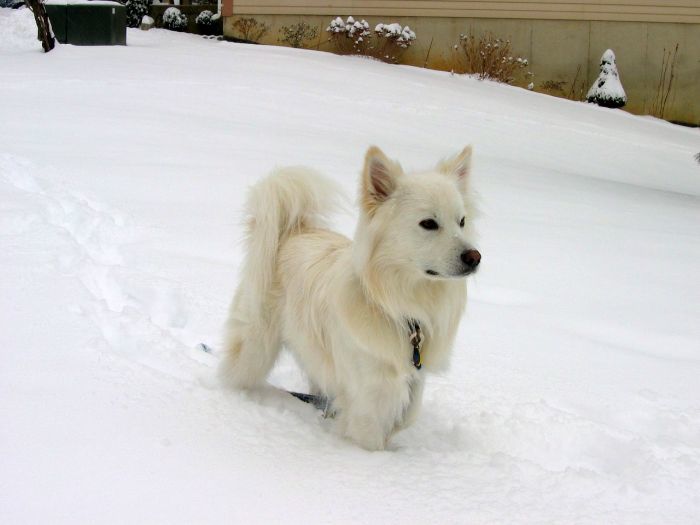
Like huskies and Akitas, American Eskimo dogs are members of the the Spitz group — a collection of guarding and sled-pulling breeds characterized by long, often white hair, and pointy ears. They are, however, much smaller than many other Spitzes; American Eskimo dogs typically weigh only 20 to 40 pounds.
Most Spitzes hail from northern locations and possess a number of adaptations that help them thrive in cold weather. This includes, among other things, a long, thick coat and a bushy tail – all of which you can see in the American Eskimo dog.
Unlike many of their close relatives, who were originally developed to haul sleds, American Eskimo dogs were tasked with guarding their families and territories. Modern members of the breed retain this slightly suspicious attitude and are quick to bark at perceived threats.
American Eskimo dogs can make good pets for beginners, and because they weren’t originally bred to be sled dogs, they aren’t quite as energetic as huskies and other sledding dogs are.
What Makes a Dog Well-Suited for the Cold?
It doesn’t take a genius to figure out that dogs with long coats are usually better suited for cold weather than those with short coats. A passing glance at the list above will confirm as much.
But there are a few other traits and characteristics that help dogs cope with the cold. Some of the most notable include:
Large Body Size
Simply put, the less skin an animal has in relation to its body weight, the slower it’ll lose heat to the environment. Accordingly, if you consider two animals with similar body shapes, the larger individual will stay warmer for longer than the smaller one.
This explains why you may need to put a doggie sweater on your Chihuahua before walking into an air-conditioned building, but your Great Dane may pant and lay on the kitchen tile for the entire summer.
And don’t forget — large dogs will also be able to stand above snow, rather than having to plough through it.
Small Ears
Ears are fantastic radiators, as they not only have a lot of skin for their weight, they’re also full of blood vessels. This makes them perfect for getting rid of excess body heat.
So, dogs who hail from warm climates tend to have large ears, while those that are adapted for cold weather usually have smaller ears.
Double Coats
Lots of dogs have long coats, but long fur doesn’t necessarily make for a good blanket (Lhasa Apsos, for example, have long coats, but aren’t particularly comfortable in low temperatures).
Dogs that are really well-suited for cold weather often have a long coat, but they always have something even better: a particularly thick double-coat.
Many breeds have a double-coat comprised of a rougher outer coat and a downy undercoat, but the dogs on this list have undercoats that are luxuriously dense and provide unparalleled warmth. Unfortunately, thick double coats eventually shed, so they aren’t without their drawbacks.
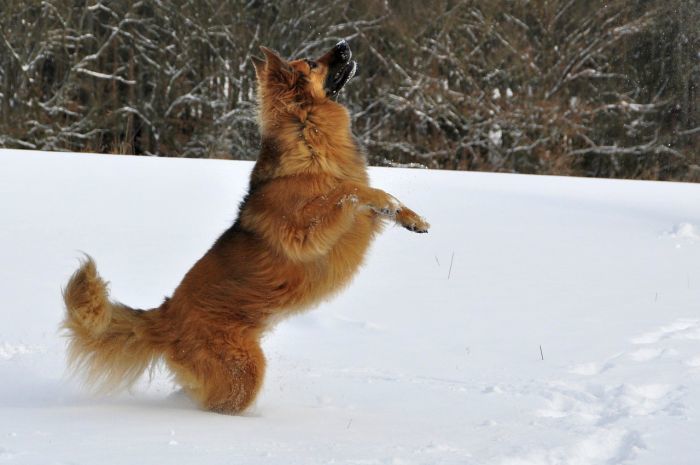
What If Your Dog Isn’t Cut Out for the Cold?
Don’t worry if your dog doesn’t like the cold weather — there are a number of ways you can help your sun-loving pooch remain comfortable in cold weather.
Booties
Booties are an easy way to protect your pup’s paws on rough surfaces, but they’ll also help keep her tootsies toasty.
Most good ones (we recommend a few top-notch dog booties here) are water-proof, so they’ll help keep your dog’s feet dry too. Booties will also provide better traction and protect your pooch’s paws, which will help prevent injuries while walking on the icy ground.
Clothing
A good dog sweater or jacket can make all the difference between a comfortable canine and one who is simply counting the seconds until she can go back inside.
Sweaters, given their snug fit, probably provide a little more warmth than jackets, but winter doggie jackets will usually provide a little better protection against the elements. In practice, there’s no reason you can’t use both if need be.
Avoid Wet Weather
If your dog isn’t built for cold temperatures, you don’t want to make things even harder on her by going for walks when it is raining or snowing.
Any moisture that gets on your dog will tend to make her colder, so you should try to take advantage of dry weather windows whenever possible.
If you can’t avoid going out when it is wet, at least use an umbrella or fit your dog with rain gear to keep her as dry as possible.
Use a Heated Dog House
We’re of the general opinion that most dogs should be allowed to sleep indoors whenever possible. But, there are some cases in which that’s simply not feasible.
Dogs who are tasked with guarding duties, for example, will often have to patrol outdoor spaces, no matter the weather.
In such cases, the most humane and responsible thing to do is provide your dog with a heated shelter of some type. Fortunately, there are a number of dog houses on the market that make fantastic cold-weather quarters for dogs who must sleep outdoors.
Is your dog part polar bear? Does she love scooting around in the snow and playing during windy winter days? Did you specifically choose her based on the breed’s tolerance of cold weather, or was that just a nice bonus? Has she ever found it too cold to go outside?
We’d also like to hear from those who have to bundle up their pooch when the mercury plummets. Have you found an especially clever way to keep her warm during walks?
Tell us all about your cold-weather canine adventures below!
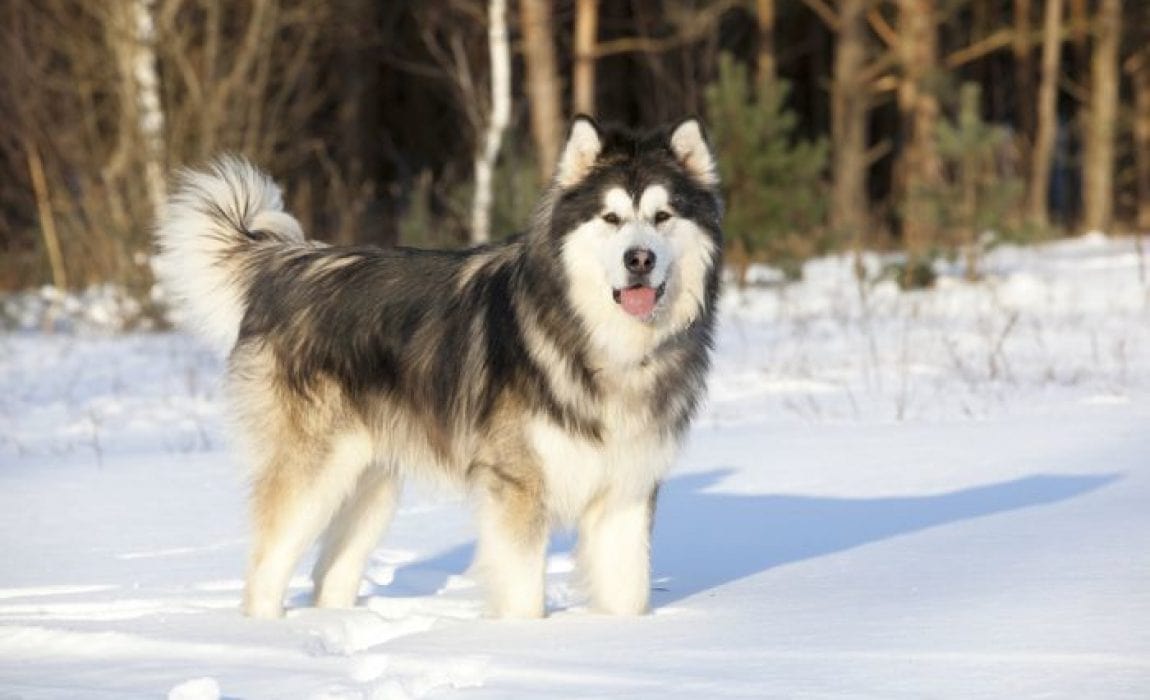
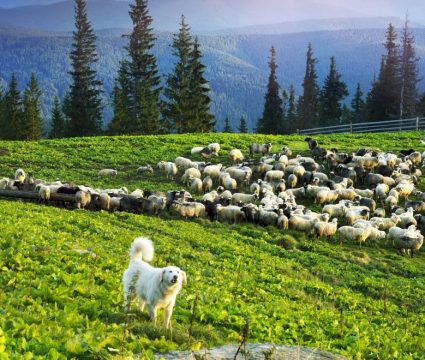
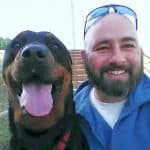



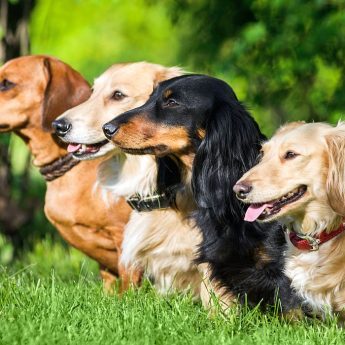
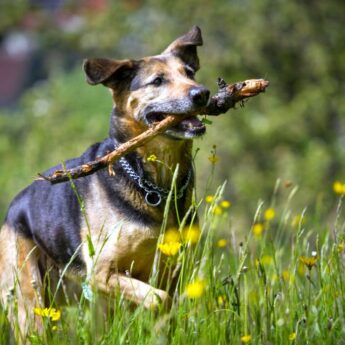
10 Comments
September 9, 2021
What about Shiba Inu?
September 9, 2021
Sure, Reiko! Shibas tend to handle cold weather pretty well.
January 8, 2021
A smaller, manageable breed, the Norwegian Elkhound is very wolf-like in appearance, They sort of look like a short (and sometimes fat) wolf. They are super smart, a little stubborn, no grooming issues, actually have little doggy smell. They also tolerate cats and other dogs. They do need consistent exercise, otherwise they will get that mobile footstool look in middle age. Lots of fun. Oh, and they have that curled, Northern dog tail. I still miss mine after 20 years.
February 1, 2020
I have two Great Pyrenees, a male and female and they are both so velcro dogs it’s not funny… But I love it!!! My male, when we travel in our truck, from the back seat he’ll place his head on my shoulder and press his cheek up against mine and look out the window. I’ve had German shepherds, golden retrievers, Doberman Pinschers, Border Collies, and pound rescues all great and wonderful dogs, but nothing beats the Great Pyrenees.
January 19, 2020
Beautiful dogs
March 2, 2019
We purchased a husky/pyrenees cross breed which became extremely ill, however after surviving whatever illness had effected him, he returned to us blind, (at 10 weeks old). The fact that we live in the country, we needed him to keep the deer out of our gardens, ( the coyote population being high), we were not sure how we were going to keep him (my wife has fur allergies). We decided to build a kennel off our heated garage, which he could access if he liked and later purchased a female pyrenees to help protect him. They both prefer to be outdoors, (we live just outside of Winnipeg, Manitoba, Canada with temperatures which can easily reach -30 degrees Celsius), yet they love to run and play and lay on the deck in the winter sunshine. One strange thing, is that our 75 lb. blind husky can take down our 95 lb. Pyrenees when they are sparing. The last Pyrenees which we owned preferred to sleep on a snow bank and never in her insulated dog house and would steal the coyotes deer kill. Look out coyotes.
January 1, 2019
I have had three Huskies. I love the breed! They have unique personalities in that the sre just as much at home with people as with their kind. Definitely a pack animal, in fact you become part of their pack. They can be a Houdini, a talker, a joker (with all kinds of expressions), a drama queen, and give great love and affection back. But they are work and you must be willing to put in th effort with this breed but if you are you will receive 10 fold the marvelous gifts this breed will give you.
November 5, 2018
We have had a high-breed wolf/Malamute. High–breeds (wolf mix) are hard to work with. We referred to our “wolf” (hereinafter HB) as our 6 million dollar dog. Wolves are extremely smart and if you have not raised a child that was meant to be a felon, you have no idea how to out smart or at least predict what your HB will do. He was a loving HB which we contributed to his Malamute part. When he was not trying to out think us he was a great pet. He was a star at our dog park as were his Malamute packs. We also had another Malamute for our Wolfe’s pack. Our Malamutes were/and are sweethearts and are dedicated to us. It is like having a giant stalker. They follow you and stay close…but… like a lot of Northern dogs they put their heads down and go wandering. After having a HB we feel that it is unfair to breed a wolf with any dog. They don’t know if they are dog or wolf and what people want from a “dog” is not always what you get from that HB. Watching the statistis on HB is sad. We got our HB after another family paid a lot of money from a breeder back east but found him to rough with the children and this family had almost no dog, let along wolf, experience. It took us about 15 minutes after we adopted him to realize that our HB would be either abandon or killed by others without some extensive training. My husband was a dog handler for the Air Force and then the police department and even he had to do some negative head shaking at some of the HB behaviors. We lost our HB at age 15 and broke our hearts but like–all—our dogs they are spoiled and we love it.
October 26, 2018
I have a Siberian Husky Dog… he is beautiful.
October 15, 2018
OMG, these dogs are so beautiful. Thanks for sharing…